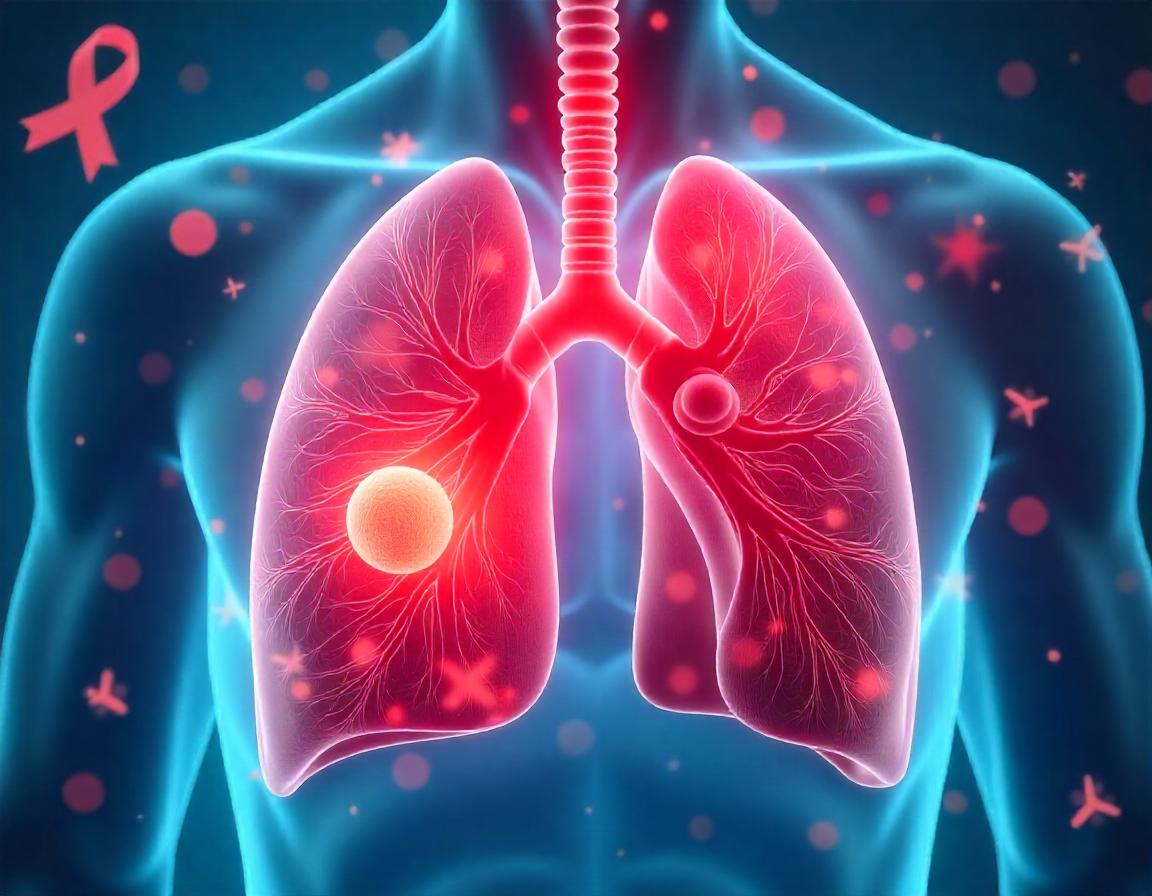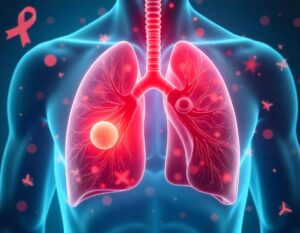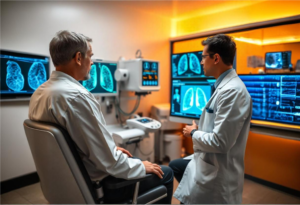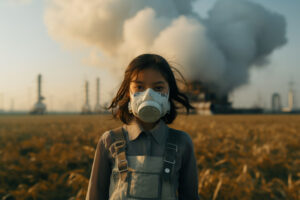Table of Contents
Lung cancer is one of the most common and deadly forms of cancer worldwide. It’s responsible for a significant number of cancer-related deaths, but with early detection, treatment outcomes can improve significantly. Understanding the signs and symptoms of lung cancer is crucial in identifying the disease at its earliest stages, when it is most treatable. In this blog, we will explore the warning signs, risk factors, and the importance of early intervention in combating lung cancer.
Understanding Lung Cancer
What is Lung Cancer?
Lung cancer occurs when cells in the lungs begin to grow uncontrollably, forming a tumor. These abnormal cells can spread to other parts of the body, a process known as metastasis. There are two main types of lung cancer:
- Non-small cell lung cancer (NSCLC): This is the most common type, accounting for around 85% of lung cancers.
- Small cell lung cancer (SCLC): A more aggressive form that grows and spreads more quickly.
Why Early Detection Matters
The survival rate for lung cancer is significantly higher when the disease is detected in its early stages. While the overall five-year survival rate for lung cancer is relatively low, it increases dramatically for those diagnosed at an early stage. Early detection often leads to more effective treatment options, which can significantly improve a patient’s prognosis. Recognizing the symptoms early can be a life-saving step.
Common Symptoms of Lung Cancer
Persistent Coughing
A long-lasting cough, particularly one that worsens over time, can be a sign of lung cancer. If you notice that a cough is not improving, or if it becomes painful, it’s important to consult a healthcare provider.
Coughing Up Blood
Hemoptysis, or coughing up blood, is a serious symptom and should never be ignored. Even small amounts of blood in the mucus or sputum could indicate that there is a tumor in the lung that’s affecting the blood vessels.
Chest Pain
Pain in the chest, especially if it worsens with deep breathing, coughing, or laughing, could be a sign of lung cancer. It’s important to differentiate between common causes of chest pain and symptoms related to lung cancer, as the latter may result from the tumor pressing against the lungs, ribs, or nerves.
Shortness of Breath
As tumors grow, they can obstruct the airways or reduce lung capacity, leading to difficulty breathing or shortness of breath. If you experience persistent or unexplained shortness of breath, it may be a symptom of lung cancer.
Hoarseness or Voice Changes
Lung cancer can cause hoarseness or other changes in the voice, particularly when tumors press on nerves related to the vocal cords. If these voice changes persist or are unexplained, it is important to seek medical advice.
Less Common but Significant Symptoms
Unexplained Weight Loss
Cancer often causes metabolic changes that lead to significant weight loss without any changes to diet or exercise habits. Unexplained weight loss could indicate the presence of cancer, including lung cancer.
Fatigue
While everyone feels tired from time to time, cancer-related fatigue is different. It’s a persistent, overwhelming sense of tiredness that doesn’t improve with rest. This kind of fatigue may be a sign of lung cancer spreading or affecting the body’s systems.
Frequent Lung Infections
Lung tumors can block airways, making the lungs more susceptible to infections like pneumonia or bronchitis. If you have recurring lung infections or find that your current treatments aren’t working, it’s worth considering a deeper investigation into the possibility of lung cancer.
Swelling in the Face, Neck, or Arms
Some lung cancers can cause blockages in veins, leading to swelling in the face, neck, or arms. This symptom is often related to a condition known as superior vena cava syndrome, where a tumor compresses the large vein that carries blood from the upper body back to the heart.
Risk Factors That Increase Lung Cancer Susceptibility
Smoking and Secondhand Smoke
The leading cause of lung cancer is smoking. Cigarette smoke contains carcinogens that can damage lung tissue over time. Even non-smokers are at risk if they are exposed to secondhand smoke, which can increase their likelihood of developing lung cancer.
Exposure to Radon Gas
Radon is a colorless, odorless gas that occurs naturally in the earth. It can accumulate in homes and buildings, especially in areas with poor ventilation. Long-term exposure to radon is a significant risk factor for lung cancer.
Environmental and Occupational Hazards
Exposure to air pollution, asbestos, industrial chemicals, and other environmental hazards can increase the risk of lung cancer. Those working in certain industries may face a higher risk due to occupational exposures.
Family History and Genetics
A family history of lung cancer or other cancers can increase your risk of developing the disease. Certain genetic mutations can also predispose individuals to lung cancer, so understanding your family’s health history can help identify your risk.
When to See a Doctor
Key Signs That Warrant Medical Attention
If you experience any of the symptoms mentioned above, it’s important to seek medical advice as soon as possible. Symptoms such as persistent coughing, coughing up blood, chest pain, and shortness of breath should not be ignored.
Diagnostic Tests for Lung Cancer
If your doctor suspects lung cancer, several diagnostic tests may be used, including:
- X-rays: To detect visible lung tumors.
- CT scans: To get detailed images of the lungs.
- Biopsies: To confirm whether a tumor is cancerous.
- Blood tests: To check for substances that might indicate cancer.
Importance of Regular Check-ups for High-Risk Individuals
Individuals who are at high risk of lung cancer, such as smokers or those with a family history of the disease, should consider regular check-ups and screenings to catch the disease early.
Treatment Options for Lung Cancer
Overview of Treatment Modalities
There are several treatment options for lung cancer, including:
- Surgery: Removal of tumors or part of the lung.
- Radiation therapy: To shrink or kill cancer cells.
- Chemotherapy: To kill or inhibit the growth of cancer cells throughout the body.
- Immunotherapy: Boosts the body’s immune system to fight cancer cells.
- Targeted therapy: Focuses on specific molecules involved in cancer growth.
Importance of a Personalized Treatment Plan
Because each case of lung cancer is unique, doctors develop personalized treatment plans based on the cancer type, stage, and the patient’s overall health. Tailored treatments offer the best chance for managing the disease effectively.
Conclusion
Lung cancer may not always present clear symptoms in its early stages, but recognizing the signs and seeking prompt medical attention can make a world of difference. Early detection significantly improves treatment outcomes, so it’s important to stay vigilant and prioritize your health. By understanding the symptoms, risk factors, and treatment options, you can take proactive steps to protect yourself or a loved one from lung cancer.
If you or a loved one is experiencing any of the symptoms, don’t wait—seek medical advice today. Early detection is key to improving outcomes, and at Apex Pulmonology, our team of expert pulmonologists is dedicated to providing comprehensive lung care. Whether it’s a consultation, diagnostic testing, or treatment options, we are here to guide you through every step of the process. Contact us today to schedule an appointment and take proactive steps toward better respiratory health.







